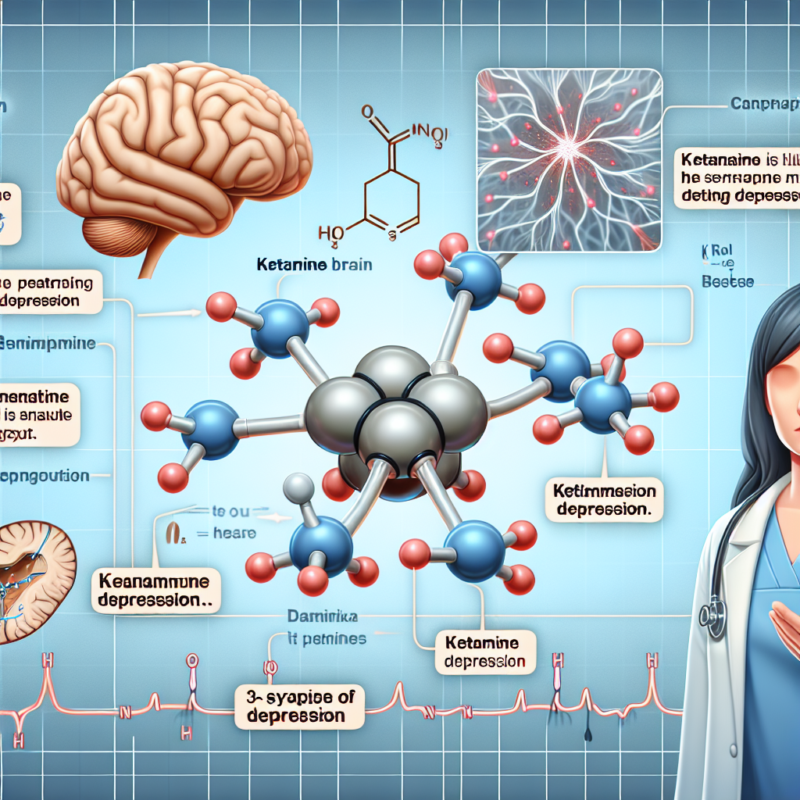Uncategorised
Ketamine for depression
The History and Evolution of Ketamine as a Treatment for Depression: Ketamine for depression
Ketamine for depression. Ketamine, a powerful anesthetic and dissociative drug, has been used for decades in medical settings for its sedative and pain-relieving properties. However, in recent years, it has gained attention for its potential as a treatment for depression. This unconventional use of ketamine has sparked both excitement and controversy in the medical community. In this article, we will explore the history and evolution of ketamine as a treatment for depression.
The first recorded use of ketamine as an anesthetic was in 1962, when it was synthesized by chemist Calvin Stevens. It quickly gained popularity due to its rapid onset and short duration of action, making it a preferred choice for surgeries and procedures. However, it wasn’t until the 1990s that researchers began to investigate its potential for treating depression.
In 2000, a study published in the Archives of General Psychiatry showed that ketamine had a rapid and significant antidepressant effect in patients with treatment-resistant depression. This groundbreaking study sparked further research into the use of ketamine for depression, and since then, numerous studies have been conducted to explore its efficacy and safety.
One of the key factors that make ketamine a promising treatment for depression is its ability to work quickly. Traditional antidepressants can take weeks or even months to show any effect, leaving patients suffering in the meantime. Ketamine, on the other hand, has been shown to have a rapid antidepressant effect, with some patients reporting improvement in their symptoms within hours of receiving the drug.
Another factor that sets ketamine apart from traditional antidepressants is its mechanism of action. While most antidepressants work by targeting serotonin or other neurotransmitters in the brain, ketamine works on a different pathway. It blocks the NMDA receptor, which is involved in the regulation of mood and emotions. This unique mechanism of action may explain why ketamine is effective in treating depression when other medications have failed.
Despite its potential, the use of ketamine for depression has been met with some controversy. One of the main concerns is the potential for abuse and addiction. Ketamine is a controlled substance and has been used recreationally for its hallucinogenic effects. However, when used in a medical setting, under the supervision of a healthcare professional, the risk of addiction is significantly reduced.
Another concern is the lack of long-term data on the use of ketamine for depression. Most studies have only looked at the short-term effects of the drug, and there is limited information on its long-term safety and efficacy. This is why the use of ketamine for depression is currently limited to treatment-resistant cases and is not considered a first-line treatment option.
In recent years, the use of ketamine for depression has evolved beyond its traditional form of administration, which is through intravenous infusion. Researchers have explored other methods of delivery, such as intranasal and oral formulations, to make the treatment more accessible and convenient for patients. These alternative methods have shown promising results and may open up new possibilities for the use of ketamine in treating depression.
In conclusion, the history and evolution of ketamine as a treatment for depression have been a journey of discovery and controversy. While it has shown promising results in treating treatment-resistant depression, there are still many questions that need to be answered. As research continues, we may see ketamine become a more widely accepted and utilized treatment option for depression. However, it is important to remember that it is not a miracle cure and should only be used under the supervision of a healthcare professional.
Understanding the Mechanisms of Action: How Ketamine Works to Alleviate Depression Symptoms

Depression is a debilitating mental health disorder that affects millions of people worldwide. It is characterized by persistent feelings of sadness, hopelessness, and loss of interest in once enjoyable activities. While there are various treatment options available, such as therapy and antidepressant medications, they may not work for everyone. This has led researchers to explore alternative treatments, and one such treatment that has gained attention in recent years is ketamine.
Ketamine is a dissociative anesthetic that has been used for decades in medical settings for its sedative and pain-relieving properties. However, in the past few years, it has been found to have a rapid and profound effect on alleviating symptoms of depression, particularly in individuals who have not responded to traditional antidepressant medications.
But how exactly does ketamine work to alleviate depression symptoms? To understand this, we must first look at the mechanisms of action of ketamine in the brain. Ketamine works by blocking a specific type of receptor in the brain called the N-methyl-D-aspartate (NMDA) receptor. This receptor is involved in the regulation of mood, cognition, and pain perception.
When ketamine blocks the NMDA receptor, it leads to an increase in the levels of a neurotransmitter called glutamate. Glutamate is known as an excitatory neurotransmitter, meaning it stimulates brain activity. In individuals with depression, there is evidence of decreased levels of glutamate in certain areas of the brain, leading to a decrease in brain activity. By increasing glutamate levels, ketamine helps to restore normal brain activity, which may be one of the reasons for its rapid antidepressant effects.
Another mechanism of action of ketamine is its effect on the brain’s reward system. In individuals with depression, there is a dysregulation of the reward system, leading to a decrease in the release of dopamine, a neurotransmitter involved in pleasure and motivation. Ketamine has been found to increase the release of dopamine, which may contribute to its ability to alleviate symptoms of depression.
Moreover, ketamine has been found to have anti-inflammatory effects in the brain. Inflammation has been linked to the development and progression of depression. By reducing inflammation, ketamine may help to improve mood and alleviate symptoms of depression.
One of the most intriguing mechanisms of action of ketamine is its ability to promote the growth of new brain cells. In individuals with depression, there is evidence of decreased neuroplasticity, which is the brain’s ability to adapt and change. Ketamine has been found to increase the production of a protein called brain-derived neurotrophic factor (BDNF), which is essential for the growth and survival of brain cells. This increase in BDNF may help to repair and restore damaged brain circuits, leading to an improvement in mood and overall well-being.
It is important to note that the exact mechanisms of action of ketamine in alleviating depression symptoms are still not fully understood. Researchers continue to study this drug to gain a better understanding of its effects on the brain and how it can be used as a treatment for depression.
In conclusion, ketamine has shown promising results in rapidly alleviating symptoms of depression in individuals who have not responded to traditional treatments. Its mechanisms of action involve blocking the NMDA receptor, increasing glutamate levels, promoting the release of dopamine, reducing inflammation, and promoting the growth of new brain cells. While more research is needed, ketamine offers hope for those struggling with depression and may pave the way for new and more effective treatments for this debilitating disorder.
Exploring the Potential Benefits and Risks of Ketamine Therapy for Treatment-Resistant Depression: Ketamine for depression
Depression is a debilitating mental illness that affects millions of people worldwide. While there are various treatment options available, such as therapy and medication, some individuals may not respond well to these traditional methods. This is where ketamine therapy comes into play. Ketamine, a dissociative anesthetic, has been gaining attention as a potential treatment for treatment-resistant depression. In this article, we will explore the potential benefits and risks of ketamine therapy for depression.
Ketamine was first developed in the 1960s as an anesthetic for surgery. However, in recent years, it has been studied for its potential use in treating depression. The drug works by blocking the N-methyl-D-aspartate (NMDA) receptor in the brain, which is believed to play a role in depression. This mechanism of action is different from traditional antidepressants, which target serotonin and other neurotransmitters.
One of the main benefits of ketamine therapy is its rapid onset of action. While traditional antidepressants can take weeks or even months to show results, ketamine has been shown to have a noticeable effect within hours. This is particularly beneficial for individuals who are in a severe depressive state and need immediate relief. Additionally, ketamine has been found to have a higher response rate in treatment-resistant depression compared to traditional antidepressants.
Another potential benefit of ketamine therapy is its ability to provide long-lasting relief. While the effects of traditional antidepressants may wear off over time, ketamine has been shown to have a longer-lasting impact. This is due to its ability to promote the growth of new brain cells and connections, which may help to alleviate symptoms of depression in the long term.
Moreover, ketamine therapy is effective in treating other mental health conditions, such as anxiety and post-traumatic stress disorder (PTSD). This makes it a versatile treatment option for individuals who may have comorbidities or have not responded well to traditional treatments for these conditions.
Despite its potential benefits, ketamine therapy also comes with some risks. One of the main concerns is its potential for abuse. Ketamine is a controlled substance and has been used as a recreational drug due to its dissociative effects. Therefore, ketamine therapy must be administered under the supervision of a trained medical professional in a controlled setting.
Another risk of ketamine therapy is its potential side effects. While the drug is generally well-tolerated, some individuals may experience side effects such as nausea, dizziness, and dissociation. These side effects are usually temporary and can be managed with proper medical supervision. However, individuals must be aware of these potential risks before undergoing ketamine therapy.
Moreover, the long-term effects of ketamine therapy are still being studied. While initial research has shown promising results, more studies are needed to determine the safety and efficacy of long-term ketamine use for depression. It is also essential to note that ketamine therapy is not a one-time treatment and may require multiple sessions for optimal results.
In conclusion, ketamine therapy has shown potential as a treatment option for individuals with treatment-resistant depression. Its rapid onset of action, long-lasting effects, and effectiveness in treating other mental health conditions make it a promising alternative to traditional antidepressants. However, it is essential to consider the potential risks and side effects before undergoing ketamine therapy. As with any medical treatment, it is crucial to consult with a healthcare professional to determine if ketamine therapy is the right option for you.

